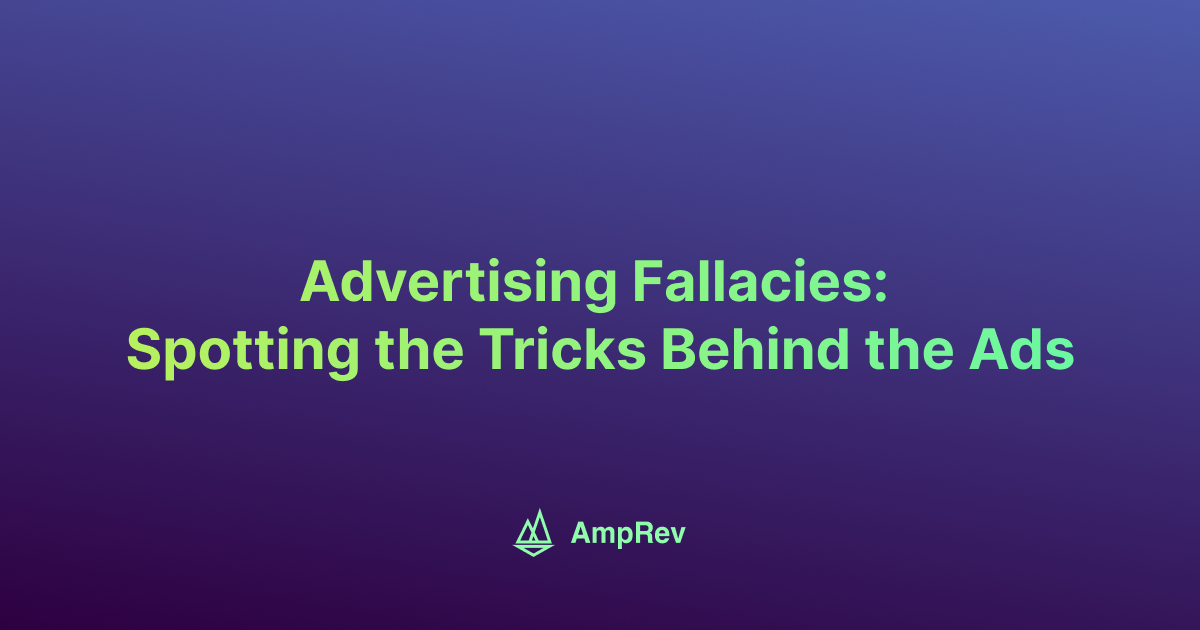Advertising Fallacies: Spotting the Tricks Behind the Ads
AmpRev

Advertising is everywhere, competing for your attention and persuading you to take action. While most marketing relies on creativity and clever messaging, some ads cross the line into questionable territory by using what are known as advertising fallacies. These deceptive techniques play on emotions, flawed logic, and manipulation to influence consumer decisions.
Let’s dive into what advertising fallacies are, explore some common examples, and discuss how brands can balance creativity with ethical practices.
What Are Advertising Fallacies?
Advertising fallacies come in many forms, each with its unique way of influencing decision-making:
- Ad Hominem Fallacy:
Instead of focusing on a product’s strengths, this approach discredits competitors. For instance, a brand might highlight a rival's unsustainable practices while ignoring its own shortcomings. The tactic shifts focus away from the brand’s actual value.
- False Dilemma Fallacy:
This tactic creates an illusion of limited choices. Ads may present a product as the only solution by ignoring other viable alternatives, forcing consumers into a narrow decision-making process.
- Bandwagon Fallacy:
Playing on the fear of missing out, these ads use phrases like “Join millions who trust us” to imply that popularity equals quality.
- Slippery Slope Fallacy:
By exaggerating consequences, this approach suggests dire outcomes if a product isn’t used. For example, “Without our product, your health will deteriorate” creates fear-driven urgency.
- Hasty Generalization Fallacy:
These ads draw broad conclusions from limited evidence, such as using a single glowing testimonial to imply universal customer satisfaction.
- Appeal to Authority Fallacy:
Featuring experts or industry figures can build trust, even if their expertise isn’t directly relevant to the product.
- Appeal to Emotion Fallacy:
By targeting feelings like nostalgia, fear, or happiness, these ads bypass logic, persuading consumers through sentiment rather than facts.
- Red Herring Fallacy:
This approach distracts consumers with irrelevant information, steering attention away from a product’s actual merits or flaws.
- Post Hoc Fallacy:
These ads imply causation where none exists, such as suggesting that using a product guarantees success or happiness without evidence.
- Equivocation Fallacy:
By using ambiguous language or clever wordplay, these ads confuse consumers about what a product truly offers, often exaggerating its benefits.
Why Do Fallacies Work?
Advertising fallacies work because they appeal to the way people process information. They grab attention, create emotional connections, and make lasting impressions. When conventional messages don’t cut through the noise, these techniques stand out, even if they rely on flawed or manipulative arguments. In the fast-paced world of digital marketing, these shortcuts can convert prospects into customers—but at the cost of trust and transparency.
How Can Brands Maintain Ethical Advertising?
Ethical advertising doesn’t mean giving up on creativity—it’s about using it responsibly. Brands that focus on transparency and honesty can still persuade effectively without resorting to manipulative tactics. Here’s how brands can maintain ethical standards:
- Highlight the strengths of your product instead of attacking competitors.
- Support claims with clear, verifiable data.
- Use emotional appeals responsibly, ensuring they align with the product’s actual value.
- Be transparent about sponsorships and clearly label promotional content.
Consumers today are savvier than ever and value authenticity. Brands that prioritize trust and integrity not only stand out but also build lasting relationships with their audiences.
Final Thoughts
Advertising fallacies might deliver quick wins, but they can erode trust over time. By recognizing these tactics, consumers can make more informed decisions, and brands can steer away from misleading practices. Ethical advertising isn’t just a moral choice—it’s a competitive advantage in a world where transparency and authenticity are increasingly valued.
For more insights into advertising strategies and ethics, explore our other articles on AmpRev's Blog.*
